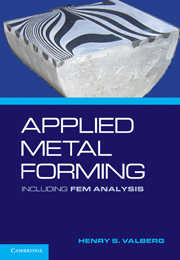Book contents
- Frontmatter
- Contents
- Preface
- APPLIED METAL FORMING
- 1 Characteristics of Metal Forming
- 2 Important Metal Forming Processes
- 3 FEA of Metal Forming
- 4 Theory
- 5 Reduction and Proportions of the Plastic Zone
- 6 Deformations from the Velocity Field
- 7 Technological Tests and Physical Simulation
- 8 Flow Stress Data
- 9 Formability and Workability
- 10 Friction and Friction Models
- 11 Thermal Effects
- 12 Experimental Metal Flow Analysis
- 13 Theoretical Methods of Analysis
- 14 Finite Element Analysis
- 15 FEA of Technological Tests
- 16 Forging
- 17 FEA of Forging
- 18 Extrusion
- 19 FEA of Extrusion
- 20 Rolling
- 21 FEA of Rolling
- 22 Drawing of Wire, Profiles, and Tubes
- 23 FEA of Wiredrawing
- 24 Sheet-Metal Forming
- Index
- References
17 - FEA of Forging
Published online by Cambridge University Press: 05 June 2012
- Frontmatter
- Contents
- Preface
- APPLIED METAL FORMING
- 1 Characteristics of Metal Forming
- 2 Important Metal Forming Processes
- 3 FEA of Metal Forming
- 4 Theory
- 5 Reduction and Proportions of the Plastic Zone
- 6 Deformations from the Velocity Field
- 7 Technological Tests and Physical Simulation
- 8 Flow Stress Data
- 9 Formability and Workability
- 10 Friction and Friction Models
- 11 Thermal Effects
- 12 Experimental Metal Flow Analysis
- 13 Theoretical Methods of Analysis
- 14 Finite Element Analysis
- 15 FEA of Technological Tests
- 16 Forging
- 17 FEA of Forging
- 18 Extrusion
- 19 FEA of Extrusion
- 20 Rolling
- 21 FEA of Rolling
- 22 Drawing of Wire, Profiles, and Tubes
- 23 FEA of Wiredrawing
- 24 Sheet-Metal Forming
- Index
- References
Summary
In this chapter, two rather different cases of forging will be considered, the first one being cold backward cup extrusion, and the second one, hot closed-die forging. During FEA, a large number of analysis results can be achieved when realistic models of the forming operations have been made. These two cases demonstrate some important results achieved this way.
Cold Forging by Backward Cup Extrusion
As explained in Sec. 2.2.3, hollow cups of metal are commonly manufactured from cylindrical workpieces, called slugs, by use of backward cup extrusion. Even though this process is called extrusion, it is often classified as a forging process and will be so considered in the following.
Let us now analyze the backward cup extrusion process visualized in the FEM model in Fig. 17.1. Only one half of the workpiece and the dies was modeled, because there is rotational symmetry around the y-axis. The mirroring option of the program, however, was used to visualize the full longitudinal cross section of the forming process as shown in Fig. 17.1. In this figure, (a) shows the initial die and workpiece configuration, (b) shows an intermediate stage of forming, and (c) shows the final thick-bottomed cup at the end of forming.
The FEM model mimics an industrial cold-forging process, where a soft-annealed slug of the alloy AA 6082 was given the cup shape shown in Fig. 17.1(c). The tooling consisted of a moving punch and a stationary container.
- Type
- Chapter
- Information
- Applied Metal FormingIncluding FEM Analysis, pp. 285 - 319Publisher: Cambridge University PressPrint publication year: 2010
References
- 2
- Cited by



